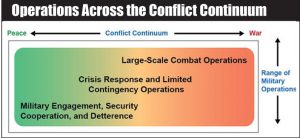Large-scale combat operations are at the far right of the conflict continuum and associated with war. Historically, battlefields in large-scale combat operations have been more chaotic, intense, and highly destructive than those the Army has experienced in the past several decades. During the 1943 battles of Sidi Bou Zid and Kasserine Pass in World War II, 5,000 American Soldiers were killed over the course of just 10 days; during the first three days of fighting the Army lost Soldiers at the rate of 1,333 per day. Even later in the war, when units were better seasoned, trained, and equipped, casualty rates remained high due to the inherent lethality of large-scale combat operations. In the Hürtgen Forest the Army sustained 33,000 total casualties over 144 days, a loss of 229 Soldiers per day. Similarly, the Battle of the Bulge cost the Army 470 Soldiers per day, for a total loss of 19,270 killed and 62,489 wounded over 41 days of sustained combat.
Large-scale combat operations are intense, lethal, and brutal. Their conditions include complexity, chaos, fear, violence, fatigue, and uncertainty. Future battlefields will include noncombatants, and they will be crowded in and around large cities. Enemies will employ conventional tactics, terror, criminal activity, and information warfare to further complicate operations. To an ever-increasing degree, activities in the information environment are inseparable from ground operations. Large-scale combat operations present the greatest challenge for Army forces.
When the Cold War ended, U.S. defense policy postulated that a new era had dawned in which large-scale combat operations against a peer threat were unlikely. This hypothesis was supported by operations throughout the 1990s. While the U.S. military applied the relative conventional superiority it developed in competition with the Warsaw Pact to dominate a large, conventionally armed opponent in OPERATION DESERT STORM, it was an exception. U.S. forces conducted contingency operations at the lower end of the conflict continuum in the Balkans and elsewhere. In 2001 and 2003 the U.S. conducted two offensive joint campaigns that achieved rapid initial military success but no enduring political outcome, resulting in protracted counterinsurgency campaigns in Afghanistan and Iraq. The focus of Army training and equipping shifted from defeating a peer threat to defeating two insurgencies and the global terrorist threat.
Adversaries have studied the manner in which U.S. forces deployed and conducted operations over the past three decades. Several have adapted, modernized, and developed capabilities to counter U.S. advantages in the air, land, maritime, space, and cyberspace domains. Military advances by Russia, China, North Korea, and Iran most clearly portray this changing threat.
While the U.S. Army must be manned, equipped, and trained to operate across the range of military operations, large-scale ground combat against a peer threat represents the most significant readiness requirement. FM 3-0 Operations provides doctrine for how Army forces, as part of a joint team, and in conjunction with unified action partners, do this. FM 3-0 is concerned with operations using current Army capabilities, formations, and technology in today’s operational environment (OE). It expands on the material in ADRP 3-0 by providing tactics describing how theater armies, corps, divisions, and brigades work together and with unified action partners to successfully prosecute operations short of conflict, prevail in large-scale combat operations, and consolidate gains to win enduring strategic outcomes.
Download a free PDF sample and learn more at: AODS6-1: The Army Operations & Doctrine SMARTbook w/SMARTupdate 1 (Guide to FM/ADP 3-0 Operations & the Elements of Combat Power)
 This article is an extract from “AODS6-1: The Army Operations & Doctrine SMARTbook, 6th Ed. w/SMARTupdate 1 (Guide to FM/ADP 3-0 Operations & the Elements of Combat Power)” by The Lightning Press. Download a free PDF sample and learn more at: AODS6-1: The Army Operations & Doctrine SMARTbook, 6th Ed. w/SMARTupdate 1 (Guide to FM/ADP 3-0 Operations & the Elements of Combat Power).
This article is an extract from “AODS6-1: The Army Operations & Doctrine SMARTbook, 6th Ed. w/SMARTupdate 1 (Guide to FM/ADP 3-0 Operations & the Elements of Combat Power)” by The Lightning Press. Download a free PDF sample and learn more at: AODS6-1: The Army Operations & Doctrine SMARTbook, 6th Ed. w/SMARTupdate 1 (Guide to FM/ADP 3-0 Operations & the Elements of Combat Power).
Browse additional military doctrine articles in our SMARTnews Blog & Resource Center.
About The Lightning Press SMARTbooks. Recognized as a “whole of government” doctrinal reference standard by military, national security and government professionals around the world, SMARTbooks comprise a comprehensive professional library. SMARTbooks can be used as quick reference guides during operations, as study guides at education and professional development courses, and as lesson plans and checklists in support of training. Browse our collection of Military Reference SMARTbooks to learn more.














































